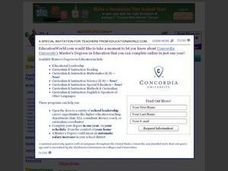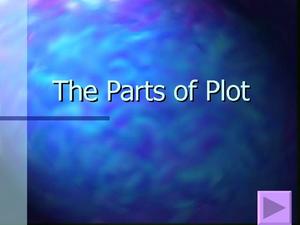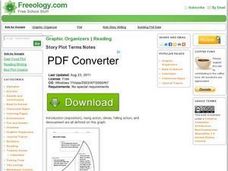Curated OER
Poetry Shopping Spree
Scholars demonstrate the ability to evaluate authors' use of literary elements such as metaphor, simile, personification, imagery, and onomatopoeia. They are provided with a checklist and must shop for poems that contain the poetry terms...
Curated OER
"The False Gems" by Guy de Maupassant
Readers must go beyond the surface level of Guy de Maupassant's story, "The False Gems," to answer the questions on this worksheet. They must draw inferences, evaluate character's actions, and analyze how irony and symbolism give depth...
Curated OER
Lesson Plan 6: Introducing the Elements of Plot-Part Two
November is National Novel Writing Month, so if your young authors are embarking on this journey, be sure they understand plot elements. This collaborative lesson fits into the context of the larger NaNoWriMo project; however, the ideas...
Curated OER
Come Fly with Me . . . Open a Book: Travels through Literature
This detailed overview of a curriculum unit suggests using travel literature to engage and stimulate your third graders’ interest in reading. The suggested reading list includes fiction and non-fiction materials and offers urban children...
Curated OER
Parts of Plot
Questions are given on each slide of this presentation, asking learners to identify parts of plot. The questions have two answers per slide for readers to choose between, multiple-choice style. The last two slides are labeled "Great Job"...
Curated OER
Parts of the Plot: Constructing A Plot Diagram
After reading "The King of Mazy May" by Jack London, learners reinforce their literary analysis skills in this SMART board lesson. The provided SMART board file allows themto define elements of a short story, and then add it to the plot...
Curated OER
Movie Riddles: An ESL Activity to Get Student Talking About Movies
Enjoy the thrill of the movies with this ESL activity! Not only can learners talk about their favorite films, but in creating riddles about their chosen movies, they can practice the skills of context clues and deductive reasoning. This...
PB Works
The Cay by Theodore Taylor
Record the plot elements of The Cay on this worksheet. Pupils note basic information about the book and answer questions about the introduction, point of view, character, conflict, rising action, climax, falling action, and resolution of...
Curated OER
Express Yourself Lesson Seed 9: Climax
Conduct a close reading of chapter 9 of The Cay. Read the chapter again and ask pupils to respond to a list of included text-dependent questions. Finish the class with the provided writing assignment, which asks learners to use textual...
Curated OER
Story Elements
Middle schoolers in particular will benefit from this simple presentation. Forty slides cover story elements like the protagonist, antagonist, and setting, and literary devices are also included. Some examples are given, but for the most...
Curated OER
Five Elements of a Story
Here’s a graphic organizer that permits learners to chart the introduction, rising action, climax, falling action and resolution of a story. The PDF file can be customized to work with any narrataive.
Curated OER
Parts of the Plot: Constructing a Plot Diagram
Sixth graders conduct a plot diagram for a short story. They identify the problem, the rising action, the climax, the falling action, and the resolution. Students are able to sequence events in a story, and identify the parts of the plot...
Curated OER
Academic Vocabulary
Arm your writers with an arsenal of literary terms. With definitions of everything from plot structure and figurative language to point-of-view and types of irony, learners will gain an understanding of elements in stories and be able to...
Curated OER
Paper Bag Book Report
Students read books and write a unique kind of book report. In this literature lesson, students use paper bags to construct projects about the books they read. Students present their projects to the class.
Curated OER
Storytelling in the Oral Tradition
Seventh graders research Greek mythological characters. They write about problems faced by middle school-aged children and how the character would handle them. Students also create story boards to accompany their oral narratives.
Curated OER
Laurence Yep's, Dragonwings
Students discuss vocabulary words and compare definitions. They read chapters 6-9 of the novel, Dragonwings, and discuss point of view, and complete a plot diagram. Then they review the four types of conflict and identify the conflicts...
Curated OER
Context Clues, Plot Structure, Conflict, and Personal Narrative Essay
What are the elements of a personal narrative? Get your class talking by reading "The Necklace" and "A Dangerous Game." The lesson focuses primarily on defining certain vocabulary terms (like context clues, plot, conflict, climax, etc.)...
Curated OER
Story Plot Terms
This literary terms handout defines introduction, rising action, climax, falling action, and denouement.
Curated OER
Making Predictions about the Climax
Fourth graders read the passage titled Hide and Seek and predict what will happen in the climax of the story by using the rising action. In this climax lesson plan, 4th graders use a worksheet provided to them.
Curated OER
Story Map
In this story map learning exercise, students read a story and find the different story elements. They fill in the setting, characters, conflict, and climax.
Curated OER
Story Pyramid
In this story pyramid worksheet, students read a story and then fill in the blanks which will give the main idea of the story. Students identify the main characters, describe the characters, setting, problem, and main events. Eight...
Curated OER
Building Fiction: Elements of a Short Story
High schoolers define and interpret the elements found in a short story. Then they identify the elements of plot found in a short story. Students also apply knowledge of plot to an original work of fiction. Finally, they identify the...
Curated OER
Literature: Plot Patterns
Students read and analyze "An Occurrence at Owl Creek Bridge" for plot patterns. In a plot summary pyramid, they organize the story elements in sequential order. To illustrate plot summary techniques, students cite examples from...
Curated OER
An Occurrence at Owl Creek Bridge Lesson Plan 5
Students continue to read the story "An Occurrence at Owl Creek". In groups, they define the word foreshadowing. They identify the points in the story that they believe are the rising action, climax, falling action and resolution. They...

























